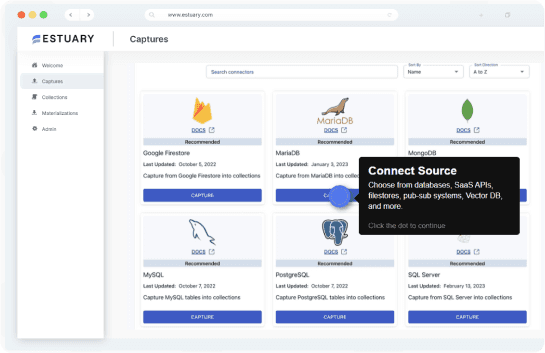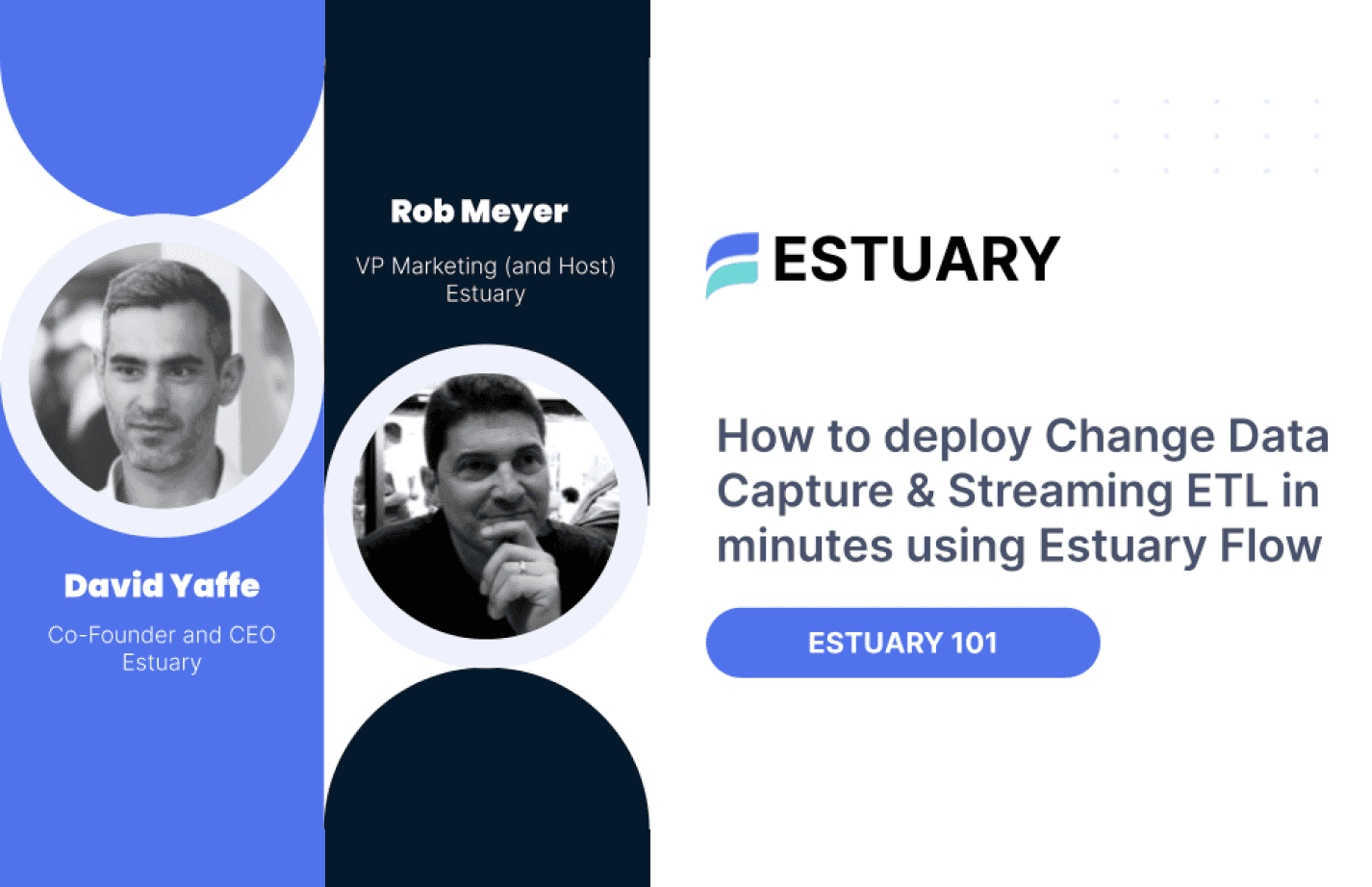Hevo Data VS Talend
Read this detailed 2025 comparison of Hevo Data vs Talend. Understand their key differences, core features, and pricing to choose the right platform for your data integration needs.
View all comparisons
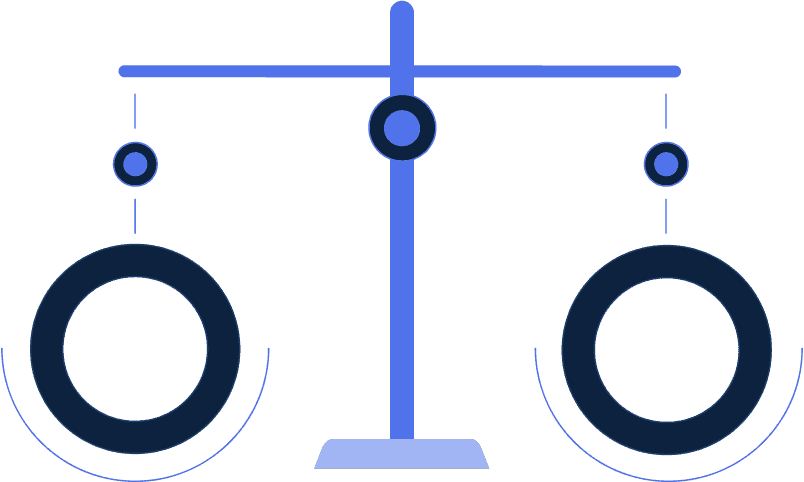

Introduction
Do you need to load a cloud data warehouse? Synchronize data in real-time across apps or databases? Support real-time analytics? Use generative AI?
This guide is designed to help you compare Hevo Data vs Talend across nearly 40 criteria for these use cases and more, and choose the best option for you based on your current and future needs.
Comparison Matrix: Hevo Data vs Talend vs Estuary
 |  |  | |||||||||||||||||||||||||||||||||||||||||||||||||||||
|---|---|---|---|---|---|---|---|---|---|---|---|---|---|---|---|---|---|---|---|---|---|---|---|---|---|---|---|---|---|---|---|---|---|---|---|---|---|---|---|---|---|---|---|---|---|---|---|---|---|---|---|---|---|---|---|
| |||||||||||||||||||||||||||||||||||||||||||||||||||||||
| |||||||||||||||||||||||||||||||||||||||||||||||||||||||
| |||||||||||||||||||||||||||||||||||||||||||||||||||||||
| |||||||||||||||||||||||||||||||||||||||||||||||||||||||
| |||||||||||||||||||||||||||||||||||||||||||||||||||||||
| |||||||||||||||||||||||||||||||||||||||||||||||||||||||

Hevo Data

Hevo is a cloud-based ETL/ELT service for building data pipelines that, unlike Fivetran, started as a cloud service in 2017, making it more mature than Airbyte. Like Fivetran, Hevo is designed for “low code”, though it does provide a little more control to map sources to targets, or add simple transformations using Python scripts or a new drag-and-drop editor in ETL mode. Stateful transformations such as joins or aggregations, like Fivetran, should be done using ELT with SQL or dbt.
While Hevo is a good option for someone getting started with ELT, as one user put it, “Hevo has its limits”.
Pros
- Ease of use: Like several other modern ELT tools, Hevo is intuitive and easy to use, especially compared to traditional ETL tools.
- ELT and ETL: Hevo has started to add ETL support including Python scripts and a new drag-and-drop editor. This is limited mostly to row-level transformations. Hevo’s main transformation support is dbt (ELT).
- Reverse ETL: Hevo supports the ability to insert source data back into the source once it’s been cleansed. This might be good for you if you’re looking for this feature. It is a very specific use case where you write modified data back directly into the source. A more general-purpose solution is to have a pipeline write back to the sources, which is not supported by most modern ETL/ELT vendors. It is supported by iPaaS vendors.
Cons
- Connectivity: Hevo has one of the lowest number of connectors at slightly over 150. You should consider what sources and destinations you need for your current and future projects to make sure it will support your needs.
- Latency: Hevo is still mostly batch-based connectors on a streaming Kafka backbone. While data is converted into “events” that are streamed, and streams can be processed if scripts are written for any basic row-level transforms, Hevo connectors to sources, even when CDC is used, is batch. There are starting to be a few exceptions. For example, you can use the streaming API in BigQuery, not just the Google Cloud Storage staging area. But you still have a 5 minute or more delay at the source. Also, there is currently no common scheduler. Each source and target frequency is different. So latency can be longer than the source or target when they operate at different intervals.
- Costs: Hevo can be comparable to Estuary for low data volumes in the low GBs per month. But it becomes more expensive than Estuary and Airbyte as you reach 10s of GBs a month. Costs will also be much more as you lower latency because several Hevo connectors do not fully support incremental extraction. As you reduce your extract interval you capture more events multiple times, which can make costs soar.
- Reliability: CDC is batch mode only, with the minimum interval being 5 minutes. This can load the source and even cause failures. Customers have complained about Hevo bugs that make it into production and cause downtime.
- Scalability: Hevo has several limitations around scale. Some are adjustable. For example, you can get the 50MB Excel, and 5GB CSV/TSV file limits increased by contacting support.
But most limitations are not adjustable, like column limits. MongoDB can hit limits more often than others. A standalone MongoDB instance without replicas is not supported. You need 72 hours or more of OpsLog retention. And there is a 4090 columns limit that is more easily hit with MongoDB documents.
There are ingestion limits that cause issues, like a 25 million row limit per table on initial ingestion. In addition there are scheduling limits that customers hit, like not being able to have more than 24 custom times.
For API calls, you cannot make more than 100 API calls per minute. - DataOps: Like Airbyte, Hevo is not a great option for those trying to automate data pipelines. There is no CLI or “as code” automation support with Hevo. You can map to a destination table manually, which can help. But while there is some built-in schema evolution that happens when you turn on auto mapping, you cannot fully automate schema evolution or control the rules. There is no schema testing or evolution control. New tables can be passed through, but many column changes can lead to data not getting loaded in destinations and moved to a failed events table that must be fixed within 30 days or the data is permanently lost. Hevo used to support a concept of internal workflows, but it has been discontinued for new users. You cannot modify folder names for the same “events”.
Hevo Data Pricing
Hevo is more expensive than Airbyte and Estuary, but still less expensive than Fivetran and various ETL vendors.
- Free: Limited to 1 million free events per month with free initial load, 50+ connectors, and unlimited models
- Starter ($239/mo for 5M rows): Offers 150+ connectors, on-demand events, and 12 hours of support as an SLA. Additional rows are $10 or more per million (~1GB)
- Business (Custom Pricing): HIPAA compliance with a dedicated data architect and dedicated account manager
Talend
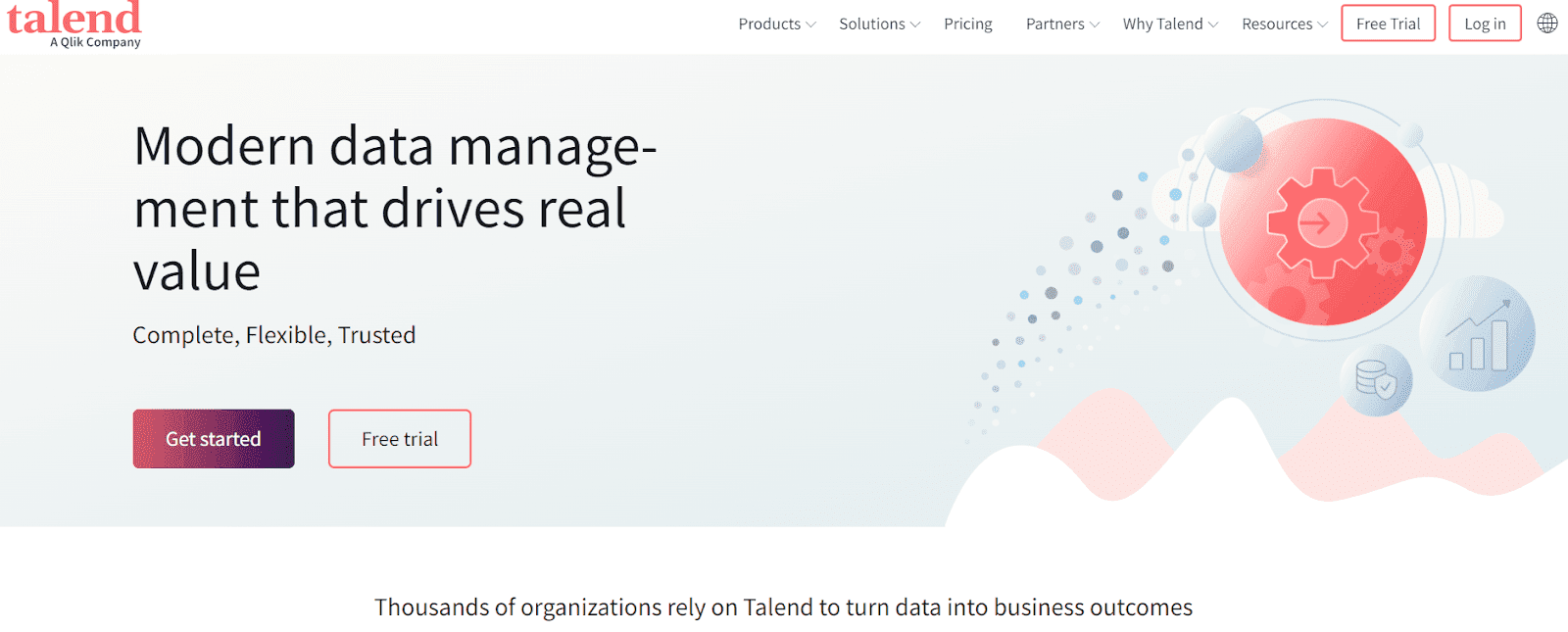
Talend, now part of Qlik, has two main products—Talend Data Fabric and Stitch, which is ELT. Talend Data Fabric is a data integration platform that, like Informatica, is broader than ETL. It also includes data quality and data governance capabilities.
Talend also had an open-source solution, Talend Open Studio, that could help you kickstart your first data integration and ETL projects. It was discontinued by Qlik in 2024.
You could use Talend Open Studio for data processes that require lightweight workflows. The majority of enterprise data pipelines would find Data Fabric more suitable.
Pros
- ETL platform: Data Fabric has rich transformation, data mapping, and data quality features that help with building data pipelines.
- Real-time and batch: Real-time support includes streaming CDC.
- Strong monitoring and analytics: Like Informatica, Talend has built up good visibility for operations.
Cons
- Learning curve: Talend has an older UI that takes time to learn. Building transforms can take time.
- Limited Open Studio features: While Open Studio is free, it’s also limited. Other open source options are less limited in their capabilities.
- Limited connectors: Talend claims 1000+ connectors. But it lists 50 or so databases, file systems, applications, messaging, and other systems it supports. The rest are Talend Cloud Connectors, which you create as reusable objects.
- High costs: Talend isn't transparent about pricing and doesn't list their current rates. Different tiers may relate to data volume, job executions, and duration. Ultimately, it costs more than most pay-as-you-go tools, as well as Stitch.
Talend Pricing
Pricing quotes are only available upon request. Potential clients should study the pricing tiers carefully, as lower tiers may not include common or desired functionality, like CDC capabilities.
Talend will likely be a higher cost option than many other ELT vendors, especially low-cost platforms like Estuary and Rivery.
Estuary
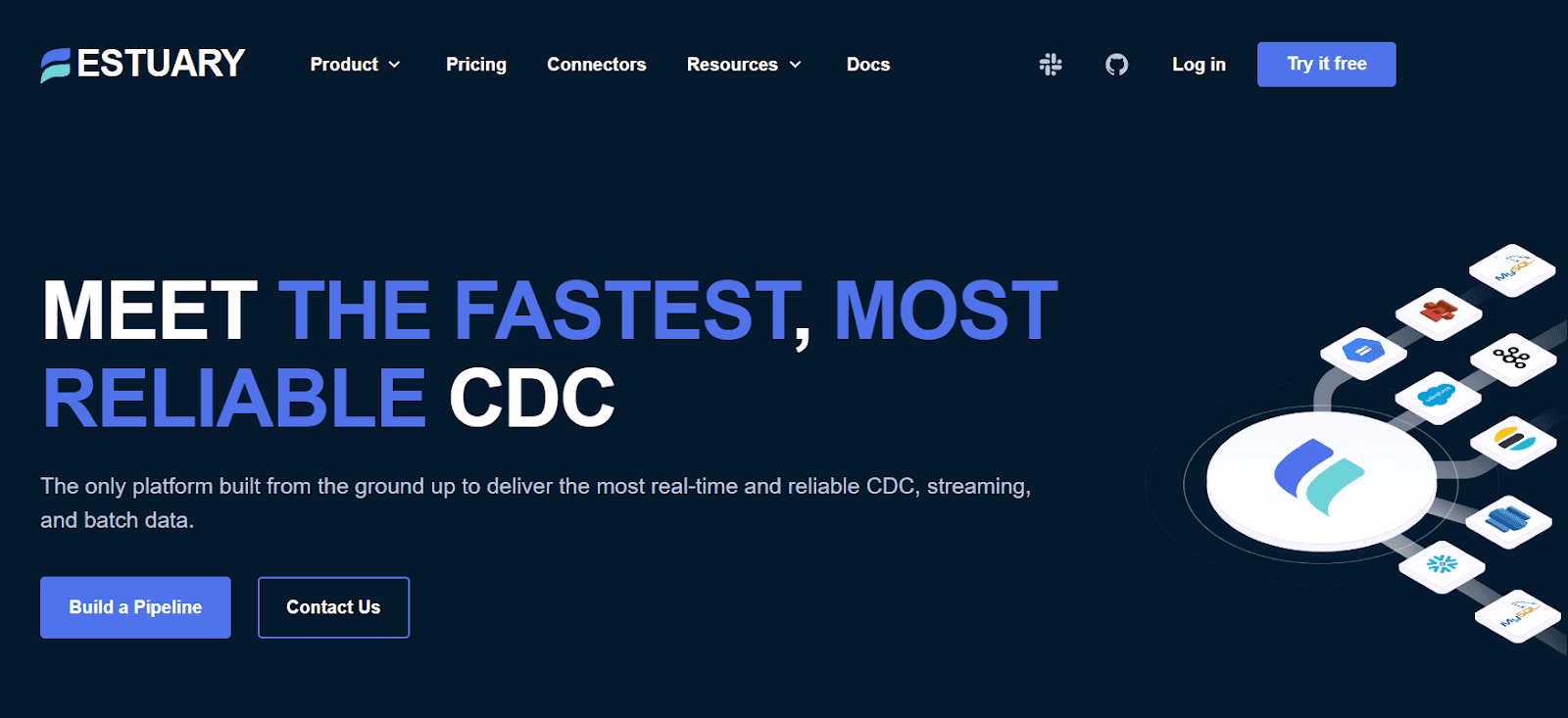
Estuary is the right time data platform that replaces fragmented data stacks with one dependable system for data movement. Instead of juggling separate tools for CDC, batch ELT, streaming, and app syncs, teams use Estuary to move data from databases, SaaS apps, files, and streams into warehouses, lakes, operational stores, and AI systems at the cadence they choose: sub second, near real time, or scheduled.
The company was founded in 2019, built on Gazette, a battle tested streaming storage layer that has powered high volume event workloads for years. That foundation lets Estuary mix CDC, streaming, and batch in a single catalog and gives customers exactly once delivery, deterministic recovery, and targeted backfills across all of their pipelines.
Unlike traditional ELT tools that focus on batch loads into a warehouse, Estuary stores every event in collections that can be reused for multiple destinations and use cases. Once a change is captured, it is written once to durable storage and then fanned out to any number of targets without reloading the source. This reduces load on primary systems, provides consistent history for analytics and AI, and makes it easy to replay or reprocess data when schemas or downstream models change.
Estuary can run as a multi tenant cloud service, as a private data plane inside the customer’s cloud, or in a BYOC model where the customer owns the infrastructure and Estuary manages the control plane. This gives security and compliance teams the control they expect from in house systems with the convenience of a managed platform.
Estuary also has broad packaged and custom connectivity, making it one of the top ETL tools. The platform ships with a growing set of high quality native connectors for databases, warehouses, lakes, queues, SaaS tools, and AI targets. Estuary also supports many open source connectors where needed, so teams can consolidate around one system while still covering niche sources and destinations. Customers consistently highlight predictable pricing, strong reliability, and partner level support as key reasons they choose Estuary instead of Fivetran, Airbyte, or DIY stacks.
Estuary Flow is highly rated on G2, with users highlighting its real-time capabilities and ease of use.
Pros
- Right time pipelines: Estuary lets you choose the cadence of each pipeline, from sub second streaming to periodic batch, so cost and freshness match the workload.
- One platform for all data movement: Handles CDC, batch loads, and streaming in one product, which reduces tool sprawl and simplifies operations.
- Dependable replication: Exactly once delivery, deterministic recovery, and targeted backfills keep pipelines stable even when sources or schemas change.
- Efficient CDC: Log based CDC captures inserts, updates, and deletes once and reuses them for many destinations, reducing load on operational databases.
- High scale architecture: Gazette and collections support large, continuous data streams with reliable throughput across multiple targets.
- Modern transforms: Supports SQL and TypeScript based transformations in motion, and integrates cleanly with dbt for warehouse side ELT.
- Flexible deployment choices: Available as cloud SaaS, private data plane, or BYOC, giving enterprises strong control over data residency and security.
- Predictable total cost of ownership: Transparent pricing based on data volume and connector instances avoids MAR based surprises and is easy to forecast.
- Fast time to value: A guided UI, CLI, and templates help most teams build their first dependable pipelines in hours instead of weeks.
- Partner level support: Customers report quick connector delivery, responsive troubleshooting, and SLAs that make Estuary feel like an extension of their team.
Cons
- On premises connectors: Estuary has 200+ native connectors and supports 500+ Airbyte, Meltano, and Stitch open source connectors. But if you need on-premises app or data warehouse connectivity, make sure you have all the connectivity you need.
- Graphical ETL: Estuary has been more focused on SQL and dbt than graphical transformations. While it does infer data types and convert between sources and targets, there is currently no graphical transformation UI.
Estuary Pricing
Of the various ELT and ETL vendors, Estuary is the lowest total cost option. Estuary only charges $0.50 per GB of data moved from each source or to each target, and $100 per connector per month. Rivery, the next lowest cost option, is the only other vendor that publishes pricing of 1 RPU per 100MB, which is $7.50 to $12.50 per GB depending on the plan you choose. Estuary becomes the lowest cost option by the time you reach the 10s of GB/month. By the time you reach 1TB a month Estuary is 10x lower cost than the rest.
How to choose the best option
For the most part, if you are interested in a cloud option, and the connectivity options exist, you may choose to evaluate Estuary.
Modern data pipeline: Estuary has the broadest support for schema evolution and modern DataOps.
Lowest latency: If low latency matters, Estuary will be the best option, especially at scale.
Highest data engineering productivity: Estuary is among the easiest to use, on par with the best ELT vendors. But it also has delivered up to 5x greater productivity than the alternatives.
Connectivity: If you're more concerned about cloud services, Estuary or another modern ELT vendor may be your best option. If you need more on-premises connectivity, you might consider more traditional ETL vendors.
Lowest cost: Estuary is the clear low-cost winner for medium and larger deployments.
Streaming support: Estuary has a modern approach to CDC that is built for reliability and scale, and great Kafka support as well. It's real-time CDC is arguably the best of all the options here. Some ETL vendors like Informatica and Talend also have real-time CDC. ELT-only vendors only support batch CDC.
Ultimately the best approach for evaluating your options is to identify your future and current needs for connectivity, key data integration features, and performance, scalability, reliability, and security needs, and use this information to a good short-term and long-term solution for you.
Related comparisons to Hevo Data
Related comparisons to Talend
Getting started with Estuary
Free account
Getting started with Estuary is simple. Sign up for a free account.
Sign upDocs
Make sure you read through the documentation, especially the get started section.
Learn moreCommunity
I highly recommend you also join the Slack community. It's the easiest way to get support while you're getting started.
Join Slack CommunityEstuary 101
I highly recommend you also join the Slack community. It's the easiest way to get support while you're getting started.
Watch


